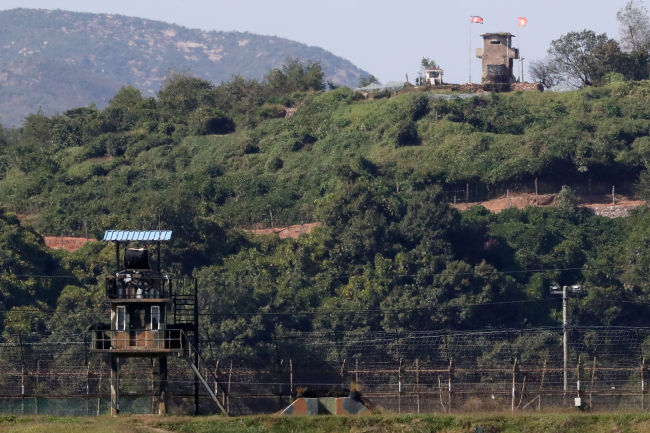The militaries of the two Koreas on Monday began removing a small portion of land mines scattered across the heavily fortified border area, as part of the agreement reached during last month’s summit in Pyongyang to ease tension and build trust.
According to the South Korean military, the removal operations took place at two sites inside the Demilitarized Zone: the Joint Security Area at the border village of Panmunjom and Arrow Head Hill in mountainous Gangwon Province.
While the North Korean army has not revealed exactly when and where the removal operation would occur, South Korea’s Ministry of National Defense said similar steps would be seen inside the North’s territory.
“In accordance with the military agreement (made during the Pyongyang summit), the removal operation is expected to take place in each other’s territories inside the JSA,” the Defense Ministry said in a statement.
 |
Two Koreas` guard posts stand each other across the DMZ. Yonhap |
During his trip to Pyongyang from Sep. 18-20, President Moon Jae-in agreed with North Korean leader Kim Jong-un to disarm the JSA, the only area inside the DMZ where the two militaries stand face-to-face along with US-controlled United Nations forces.
The South Korean military will send engineering units to the South-controlled territory at the JSA. The units will also remove landmines scattered near the jointly controlled area, such as observatories and small forests, the ministry said.
The ministry said the clearing of land mines inside the JSA will last for 20 days. In the meantime, the two Koreas and the UN Command will discuss ways to disarm the zone such as by pulling out troops, weapons and guard posts.
“Most of our efforts are to find out how many land mines are buried there, because we believe there are not many land mines left at the JSA as there have been many personnel exchanges” said a defense official, requesting anonymity due to the sensitivity of the issue.
Military officials have predicted that once the disarming measure is implemented, the JSA will look similar to what it had been like before the 1976 axe murder incident, when rank-and-file guard posts were banned from carrying heavy firearms -- even pistols.
Regarding Arrow Head Hill, where remains from the Korean War are believed to be buried after a fierce battle over the control of a strategically important hilltop position, the ministry aims to remove the land mines by the end of November before a joint excavation project kicks off.
The South Korean military suspects that about 300 South Korean, French and US soldiers are buried in the area. After building a cross-border road and forming a joint excavation team, the two Koreas will launch a seven-month effort to locate remains in April.
“In parallel with the removal operation, we are going to proceed with the construction project of connecting roads between the two Koreas, with the aim of finishing it by the end of this year,” the Defense Ministry said.
While the removal of land mines is hailed as the “first step” to carrying out the military aspects of the agreement made at the Pyongyang summit, completely removing the mines would require tremendous time and efforts, analysts said.
Experts believe the South Korean and US militaries had planted about 1 to 1.2 million landmines south of the DMZ, which measures 250 kilometers in length and 4 kilometers in width. North Korea, for its part, is considered to have put about 800,000 to 1 million mines on its side.
The South Korean Army estimated that it would take about 200 years to completely remove land mines buried in the DMZ, which is of a size equivalent to Yeouido, an 8.4-square-kilometer island near downtown Seoul.
“Even if we deployed 11 front-line engineering units to the DMZ and nearby area, it would take about 200 years to completely remove land mines scattered in the two Koreas,” an Army official said during a meeting with reporters last month.
By Yeo Jun-suk (
jasonyeo@heraldcorp.com)








![[Today’s K-pop] Blackpink’s Jennie, Lisa invited to Coachella as solo acts](http://res.heraldm.com/phpwas/restmb_idxmake.php?idx=644&simg=/content/image/2024/11/21/20241121050099_0.jpg)



